Weekend Analysis: A Path To Forex Profits
Secondly, the analysis will help you to set up your trading plans for the coming week, which in turn will help you to decide what trading plans you might want to implement. Remember, shooting from the hip can leave a hole in your pocket! Weekend analysis should be more akin to an architect preparing a blue print from which he will take the steps, based on his blue print, to construct the different aspects of the building he's designed.
Finally, the reason for undertaking a weekend analysis is to build a routine preparation method that will help to build a trading plan in the area in which you are focusing so you can establish the necessary mindset for the upcoming week. A good analysis is how you can "psych" yourself up for the oncoming trading activity. (Check out 9 Tricks Of the Successful Trader for more.)
Preparing for the WeekSince this is a forex article, the emphasis is on the necessary preparation for trading forex during the coming week. But the preparatory steps can also be used and are helpful if you trade stocks, bonds or commodities. It's important to remember that none of the markets are actually separate, or trade in a vacuum. All the markets are interdependent, so that in a global economy the purchase of bonds, equities, goods and services all have an effect on the levels of supply and demand for currencies. Therefore, the price levels of the various currencies will vary when money flows around the world as investment searches for the highest and safest yields. (For a background, see our Forex Tutorial.)
Understand the Drivers
The art of successful trading is partly due to an understanding of the current relationships between markets and the reasons that these relationships exist. It is important to understand the causative factors that are in play at the moment. Remember, though, that these relationships can and do change over time. Once you have a grasp on the existing relationships, then a study of price charts and the statements of the pundits, insiders, brokers and news services can be either reinforcing or ignored depending on your particular reading of the circumstances.
For example, a stock market recovery could be explained by investors who are anticipating an economic recovery. These investors believe that companies will have improved earnings and, therefore, greater valuations in the future. Hence they believe that now is a good time to buy! Or it can be that speculation, based on a flood of liquidity, is fueling momentum and that good old greed is pushing prices higher and higher until all players are on board so that the selling can begin.
A weekend analysis should be a basis for an understanding of the circumstances currently in play. These are the true fundamentals. Therefore the first question to ask is, why? Why are these things happening? What are the drivers behind the market actions?
Technical Drivers
Many technical analysts believe that patterns or certain price levels on charts can also be the drivers of trader behavior. They believe that so many traders are watching for these patterns that they become self-fulfilling prophecies. There has long been a debate, for example, whether a Fibonacci level is a number that is a measurement of some natural force or whether it is valid just because so many people watch for the number to occur and then trade accordingly. Whatever the reason, there are certain patterns and levels that will trigger trader action. (For more, see Can Technical Analysis Be Called A Self-Fulfilling Prophecy?)
The News
The news also fuels actions. Traders wait for the news releases to confirm or deny their hypotheses and then enter or exit their trades. If these news releases occur at certain technical levels then they attract even more trader activity and can increase the odds of a successful trade. Not every news release is always valid for timing a trade. Those releases that occur at specific chart confluences can have a more dramatic effect on the volatility of the market and will provide better trading opportunities. (To learn more, see Trading On News Releases.)
Setting Up a Trading PlanBy doing a weekend analysis, a trader can prepare for the coming week and, depending on the type of trading he or she likes to do, such as scalping the news, or trading the five minute charts or waiting for a swing trade setup, he or she will have a blueprint to guide his trading. The old adage of "plan your trade – and trade your plan," is sage advice.
Chart the IndexesIt is helpful for a trader to chart the important indexes for each market on a longer time frame. This exercise can help a trader to determine relationships between markets and whether a movement in one market is inverse or in concert with the other.
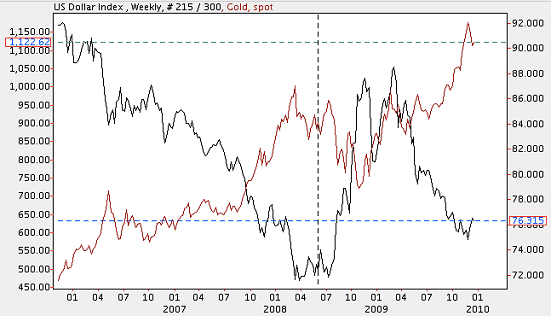 |
| Figure 1 |
| Source: netdania.com |
As you can see in Figure 1, there is an inverse relationship between gold and the dollar. As gold goes down in price, the dollar increases and vice a versa.
For example, in 2009, gold was being driven to record highs. Was this move in response to the perception that paper money was debasing so rapidly that there was a need to return to the hard metal as a store of value? Or was this the result of cheap dollars fueling a commodities boom? Or both? Could the speculators be promoting the gold hedge concept to attract dollars from
Main Street
Now that we know that gold has an inverse relationship with the dollar, we can ask ourselves what will happen if gold sells off, or what would happen to gold if the dollar appreciates? We would expect an appreciating dollar to reduce the price of gold. Could we also expect a sell off in gold to have an impact on the dollar? Probably not, because many other commodities, stocks and bonds all impact the dollar, not only gold. (Learn more in Using Technical Analysis In The Gold Markets.)
So let us then turn to the dollar index chart to try and determine if there is a potential trade set-up. In this instance we note that the dollar has traded down to a level of 75.00, which is at the 127.8 extension of the previous upswing. It is also trading at a 78% retracement of the swing from March, 2008 through November, 2009.
This indicates a potentially strong resistance level for the dollar.
| Figure 2 |
| Source: netdania.com |
The dollar index should bounce off of the 78% retracement from the low of March 2008 to the high of April 2009. At this level it is worth listening closely to the pundits as to how they explain why the dollar should start increasing in value against other currencies, especially in the light of the consensus at the time that the dollar was likely to weaken against the basket of currencies due to the threat of future inflation. At these levels it is worth watching the news and listening to the experts to garner clues as to what the sentiment is. If the markets are going to turn, sentiment will start to shift in favor of the turn and a trader can capitalize on this fact. Is There a Consensus in Other Markets?By charting other instruments on the same weekly or even monthly basis, we can gain a perspective of whether or not the markets are reaching a turning point consensus. Then we can take advantage of the consensus to enter a trade in an instrument that will be affected by the turn. For example, dollar yen indicates an oversold position with talk in the market place that the BOJ could intervene to weaken the yen. Japanese exports are affected because of the strong yen. Without any weakening of the yen, a Japanese recovery was likely to be impaired. (Learn more in The U.S. Dollar And The Yen: An Interesting Partnership.)
Gold Chart Provides Interesting PerspectiveThe gold chart indicates that a level is being reached at which many traders could take profits. A cheap dollar has fueled a gold rally. The dollar has enabled a carry trade in gold, but at some point there will be profit taking and I would look to a Fibonacci level to time a sell off. (Check out Taking The Magic Out Of Fibonacci Numbers for more.)
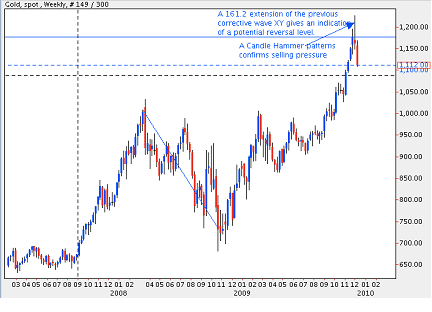 |
| Figure 3 |
| Source: netdania.com |
To find a currency trade for the coming week, a look at whether the USDJPY indicates that there is support at around the 85 level. At the double bottom around 85.00 it would be worth placing an order in the market to go long the USDJPY with a stop at say 84.50. Since there was no sure fire way of knowing whether the USDJPY will trade lower than 84.00, one had to enter a trade with a tight stop and wait and see. If you get stopped out, wait for the appropriate signal on a shorter-term chart to take the trade again.
The chart below, Figure 4, which depicts the USDJPY, is a monthly showing a double bottom. The currency was also trading down to a 161.8 extension of the wave marked with a blue line. This adds to the possibility that there would be a strong buying action of dollars against the yen at that level.
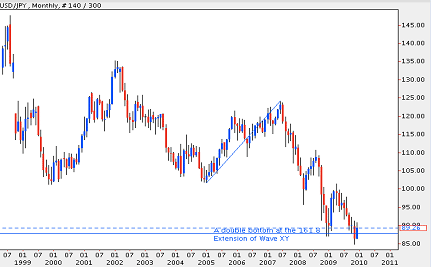 |
| Figure 4 |
| Source: netdania.com |
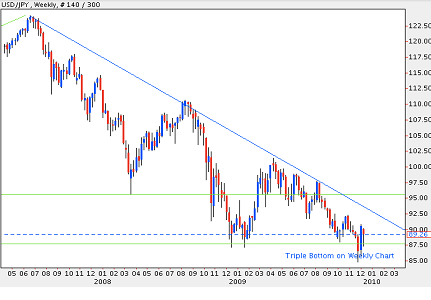 |
| Figure 5 |
| Source: netdania.com |
On the weekly chart of the USDJPY, Figure 5, we can see a triple bottom. Our analysis and radar is now heightened to a long USDJPY trade, which we can take on a shorter time frame, depending on our personal preferences. The longer-term charts are suggesting a possible bounce as the dollar strengthens, gold weakens and the dollar gains against the yen.
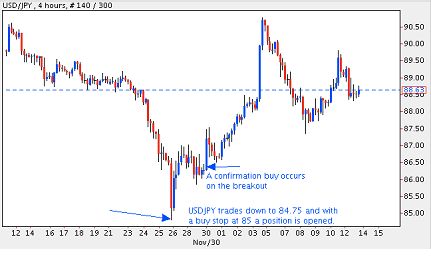 |
| Figure 6 |
A trade could have been taken on the four-hour chart. In this case there is a 400 pip move to the upside. This was a high odds trade and easy to detect. Not every trade is so obvious! If the move has already occurred, then the question is whether to chase the trade or not. Of course there are trading systems that buy on pullbacks into the trend and so on. Each trader has to determine his own methodology and test it over a period of time to determine the expectancy of the system. Consistency is what counts.
(To learn more, read Devising A Medium-Term Forex Trading System.)
To Trade or Not to TradeThere is a much higher chance of a successful trade if one can find turning points on the longer time frames, then switch down to a shorter frame to fine-tune an entry. The first trade can be at the exact Fibonacci level or double bottom as indicated on the longer term chart, and if this fails then a second opportunity will often occur on a pullback or test of the support level.
Look for the low hanging fruit and be patient. Patience, discipline and preparation will set you apart from traders who simply trade on the fly without any preparation. (For more tips, read The Most Reliable Indicator You've Never Heard Of.)
by Selwyn Gishen,


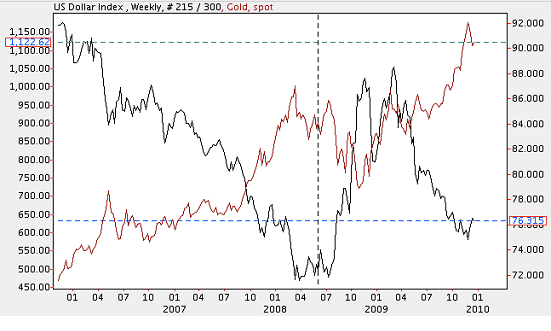
No comments:
Post a Comment